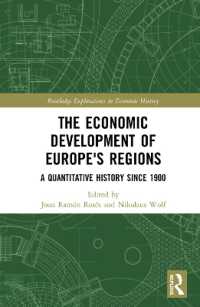- ホーム
- > 洋書
- > 英文書
- > Nature / Ecology
Full Description
Making IWRM everybody's business is the underlying philosophy of this publication. IWRM literature is normally aimed at academics, leaving out most of the stakeholders without whose participation there can be no implementation of IWRM. These are a large section of development professionals, the civil society, local communities, government officials and even the private sector. IWRM also involves professionals from many different fields, such as engineers, economists, and social scientists who also need to understand IWRM if they are to make effective contribution to the reform and implementation process. Publications by different organisations focus on their own definitions and programmes. There needs to be better exchange of information, methodology and coordination between the different organisations that promote IWRM. Through this document the authors have tried to introduce the concept of IWRM and bring together various definitions prevalent today, without any particular focus on any one definition or organisation. They try to explain the normative, strategic and operative dimensions of IWRM in a way that is easy to understand even for the least knowledgeable. The language and terminology used is simple and the authors avoid the use of 'jargon' and 'rhetoric'.
Contents
Foreword; Acknowledgements; List of Tables, Figures, Boxes and Appendix; Acronyms; Preface; Part A: Understanding Integrated Water Resources Management; Section I: Understanding IWRM; Introduction; Need for Integrated Water Resources Management; Water Related Challenges; Management Challenges: Stewardship and Governance; Multiple Aspects of Water Management; Definitions of IWRM; Principles of IWRM; Implementation of IWRM; Important Cross-cutting Elements in IWRM Implementation; Constraints and Questions in IWRM Implementation; Section II: IWRM, Floods and Droughts; Introduction; Floods; Drought; IWRM as a Risk Reduction Strategy; Section III: Overview of Case Studies; IWRM Principles and Implementation Processes in the Case Studies; Section IV: Conclusions; Part B: Case Studies; Case Study 1: Land and Water Management Planning in Warangal District, Andhra Pradesh, India; Case Study 2: Farmer Managed Groundwater Systems: Coping with Drought in Andhra Pradesh, India; Case Study 3: Restoring Water Flows in the Deschutes River, Oregon, USA; Case Study 4: Emphasising Catchment Management in the Ping River Basin, Thailand; Case Study 5: Conservation and Management of Laguna de Bay, Philippines; Case Study 6: Managing Cambodia's Great Lake: The Tonle Sap; Case Study 7: Institutional Capacity Building: Bang Pakong Dialogue Initiative; Case Study 8: IWRM at the Grassroots: Gagas River Basin, Uttaranchal, India. Case Study 9: Decentralisation through Policy Reforms: Lerma Chapala Basin, Mexico; Case Study 10: Sharing the Mekong River Basin: Issues and Challenges for Sustainable Development; Case Study 11: Transboundary Cooperation: Rhine River Network, Europe; Case Study 12: Promising Approaches in Water Resources Management in the Drinking Water Supply and Sanitation Sector: IRC Project; Index.
-

- 電子書籍
- comic Berry's 愛したいの…
-

- 洋書電子書籍
- 軍事におけるリーダーシップ(第6版)<…






